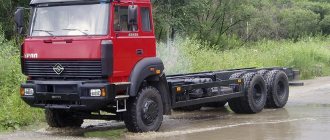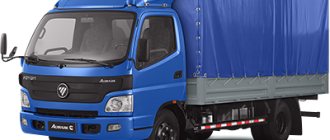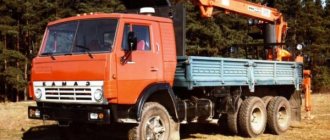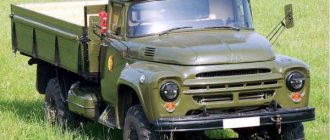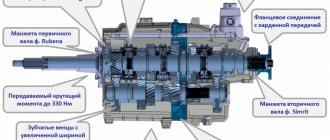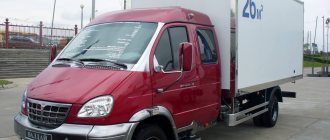GAZ 53 was produced by the Gorky Automobile Plant for more than thirty years and gained enormous popularity among the population of our country. Since the beginning of production, the model has been constantly modernized, and the last basic model is the GAZ 53 12, which has been in production since 1983.
Classic GAZ 53 early modification
About the areas of application and modifications of the GAZ-53
On its not particularly powerful shoulders, the GAZ-53 nevertheless “rolled” at least half of the entire economy of the Country of Soviets. It's hard to find where this ubiquitous truck has NOT been used. From the “gait” for emergency crews and the “paddy wagon” for criminals to mobile fuel tankers and truck tractors that hauled containers - everything that was not installed on the GAZ-53 chassis!
These cheap, simple and unpretentious trucks have become widespread in agriculture. In the 70s/early 80s of the 20th century, on the average Soviet collective farm, 80% of the truck fleet consisted of GAZ-53. Only in the second half of the 80s did this ratio begin to change towards an increase in the share of ZIL-130, which, by the way, in Soviet times did not cost much more than GAZon.
GAZ-53 of the 60s and 80s both look noticeably different from each other, and in a technological sense these are two quite different trucks. Not only are their engines completely different, but also many other design elements.
After all, over the years of production, the GAZ-53 has experienced three major and many minor upgrades and improvements. The Gorky Automobile Plant tried to promptly respond to “signals from the field” and eliminate problems identified during operation.
Thus, already in the first years of the distribution of the new truck model across the country, it became obvious that the axles from the previous generation - GAZ-51, were no longer suitable for the 53rd, and the 82-horsepower engine from the 51st GAZon, although forced, did not respond the increased needs of the new machine. During 1964/65, serial production of the GAZ-53 was launched, equipped, instead of an in-line six-cylinder engine, with a V-shaped eight (115-horsepower ZMZ-53 engine), as well as modified and reinforced axles.
An interesting, half-forgotten fact: the cladding and, accordingly, the appearance of the GAZ-53 of the first releases were very noticeably different from the appearance of the car we are accustomed to. For example, the headlights were located above the direction indicators. However, unfortunately, not a single original LAWN of that very first generation has survived to this day. But he remained captured on film in some famous films of that time, in particular “Happy Troubles” (1964), “Foreigner” (1965), “Beware of the Car” (1966), “Three Poplars on Plyushchikha” (1967).
GAZ-53F (1961—1967)
By the way, a curious film curiosity is associated with the GAZ-53, which has already become familiar to everyone. In the famous film “The Meeting Place Cannot Be Changed,” in the episode when gang members are driving Volodya Sharapov in a GAZ-AA bread van through Moscow at night, a green GAZ-53 was inappropriately included in some shots. (The film takes place in 1946).
"GAZ-53A" (1965–1983)
Three main, basic modifications of the truck rolled off the assembly line under the following factory indices:
- GAZ-53F (1961-1967) - flatbed truck and universal chassis with a forced in-line 6-cylinder GAZ-51 engine with a power of 82 hp.
- GAZ-53A (from June 1965 to 1983) - flatbed truck, dump truck and universal chassis with a ZMZ-53 engine - V-shaped 8-cylinder, 115 hp.
- GAZ-53-12 (from 1983 to January 1993) - flatbed truck, dump truck and universal chassis with an eight-cylinder V-shaped engine ZMZ-53-11 with a power of 120 hp.
According to the power, the load capacity of the three generations of the 53rd LAWN also differs. The GAZ-53F was declared to have a 4-ton capacity, although in fact it only carried 3 tons on board, and 4 tons was an almost unbearable load for it. The GAZ-53A became a real four-ton truck. The power of the GAZ-53-12 engine already allowed it to freely carry not only the 4.5 tons declared by the manufacturer, but also 5 tons “with kopecks”.
GAZ-53-12 (1983-1993)
In addition to the basic ones, there are dozens of modifications and versions of the GAZ-53 made on their basis, intended for use for specialized purposes. Among them -
- Military modification of the GAZ-53N with an additional 105 liter fuel tank, a pre-heater and a set of additional equipment.
- The widely used KAVZ-685 and Kuban based on the GAZ-53. They were produced on the GAZ-53-40 chassis, equipped with softer springs and telescopic shock absorbers, a fuel tank from the GAZ-66, a modified brake system and electrical equipment.
- GAZ-53-02 – dump truck.
- A special chassis designed for the GAZ-SAZ dump truck (SAZ-3503).
- GAZ-53-05 is a truck tractor (it was not widely used, because any of the three engines of the 53rd GAZon was too weak for such “exercises”).
- GAZ-53-19 and GAZ-53-27 - versions developed in 1984, running on liquefied gas; with engines of 105 and 100 hp. respectively.
GAZ-53 trucks were exported to almost all socialist countries, and from capitalist countries to Finland and Belgium.
Serious assembly production of these trucks, from Soviet vehicle kits, was organized in Bulgaria and Cuba. Moreover, the Bulgarian enterprise Madara produced the GAZ-53 from 1967 to 1991, increasing production volume to 3,000 cars per year in the 80s. And already from the beginning of the 70s, it equipped them with Bulgarian-made engines.
Export versions of the truck were produced with the factory designations GAZ-53-70 and GAZ-53-50 (especially for the tropics). As already noted, the number of specialized versions based on the GAZ-53 chassis is difficult to calculate. These include mobile repair shops, fire trucks, truck cranes, ladder trucks, garbage trucks, loader cranes, fuel tankers, etc. and so on.
This is interesting: How often should you change the battery in your car?
Description of GAZ-5312, photo
This is a flatbed, rear-wheel drive, hooded truck that was produced from 1983 to January 1993 (that is, it was the last in the family to be discontinued, giving way to the 3307 model). The cabin has rounded shapes throughout. There is not a single sharp corner in the exterior. The radiator grille, compared to earlier modifications, has become simplified. Complex stampings disappeared from it, but the number of holes remained the same. The exterior mirror housings have become plastic and increased in size.
Appearance of the GAZ-5312 car
The interior is a kingdom of bare metal. There is no upholstery of any kind (even the most modest) even on the interior door panels. There is minimal plastic here. There is no power steering at all, so turning the huge steering wheel requires remarkable strength. The speedometer occupies the central place on the dashboard. On the sides of it there are 4 more smaller devices, as well as several control lamps. Moreover, there is no tachometer. The ignition switch is also located here on the dashboard. In the middle of the panel there is a small drawer for small items. And on the right is a handle to hold on to.
Instead of separate armchairs, the “Lawn” had a one-piece three-seater sofa with a single back and pillow. Drivers used this if they wanted to sleep. The factory did not provide belts on the “53s” - then no one thought about safety in freight transport.
Driver's cabin
How much does a truck weigh? How to find out the weight of a truck?
The answer to this fairly common question is in the table below.
| Utility vehicles | Truck weight in kg |
| How much does a Gazelle weigh (weight of a Gazelle 3302 car) | 1850 kg |
| How much does Gazelle weigh (weight of Gazelle car 33023) | 2050 kg |
| How much does a Gazelle weigh (weight of a Gazelle car 33027, 330202) | 2100 kg |
| How much does Gazelle weigh (weight of Gazelle car 330273) | 2300 kg |
| How much does a Gazelle weigh (weight of a Gazelle 2705 car) | 2000 kg |
| How much does Gazelle weigh (weight of Gazelle car 330232) | 2220 kg |
| How much does Gazelle weigh (weight of Gazelle car 2752) | 2170 kg |
| How much does Sobol 2752 weigh (weight of the Sobol 2752 car) | 1880 kg |
| How much does Sobol 2217 weigh (weight of car Sobol 22171) | 2130 kg |
| Trucks | |
| How much does GAZ 53 weigh (weight of GAZ 53 truck) | 3250 kg |
| How much does GAZ 66 weigh (weight of GAZ 66 truck) | 3440 kg |
| How much does GAZ 69 weigh (weight of GAZ 69 truck) | 1525 kg |
| How much does GAZ 69A weigh (weight of GAZ 69A truck) | 1535 kg |
| How much does a ZIL car weigh (weight of a ZIL 130 truck) | 4300 kg |
| How much does a ZIL car weigh (weight of a ZIL 131 truck) | 6790 kg |
| How much does a ZIL car weigh (weight of a ZIL 157KD truck) | 5050 kg |
| How much does a ZIL car weigh (weight of a ZIL truck 433360 | 4475 kg |
| How much does a ZIL car weigh (weight of a ZIL 431410 truck) | 4175 kg |
| How much does a ZIL car weigh (weight of a ZIL 431510 truck) | 4550 kg |
| How much does a MAZ 5551 car weigh (weight of a MAZ 5551 truck) | 7470 kg |
| How much does a MAZ 53366 car weigh (weight of a MAZ 53366 truck) | 8200 kg |
| How much does the Ural 375 weigh (weight of the URAL 375 truck) | 7700-8000 kg |
| How much does the Ural 377 weigh (weight of the URAL 377 truck) | 6830-7275 kg |
| How much does the Ural 4320 weigh (weight of the URAL 4320 truck) | 9750 kg |
| How much does Ural 5557 weigh (weight of URAL 5557 truck) | 9980 kg |
truck weight, truck weight, how much does a truck weigh, car weight, how much does a car weigh, MAZ weight, ZIL weight, Kamaz weight, how much does a MAZ weigh, how much does a ZIL weigh
Engine
GAZ 53 was equipped with a variety of engines. The first modifications were equipped with 6-cylinder GAZ 11 units. They were distinguished by significant fuel consumption (up to 25 l/100 km) and simplicity of design. The engine power (82 hp) was not enough for the truck.
The GAZ 11 engine was replaced by the ZMZ 53 unit. Most versions of the GAZ 53 were equipped with it. The engine had a cast cylinder block and a classic V-shaped monoblock design. Cast iron sleeves and block cavities formed the water cooling jacket of the unit. The piston group was cast from aluminum alloy, the block head from Al-4 alloy. The crankshaft was made of cast iron. It was mandatory to undergo static and dynamic balancing. The engine received a K-126 carburetor and a contact ignition system. The engine used a closed liquid cooling system with a water pump.
Characteristics of the ZMZ 53 motor:
- working volume – 4.25 l;
- rated power - 115 hp;
- maximum torque – 284.5 Nm;
- number of cylinders – 8;
- compression ratio – 7.6.
The third modification of the GAZ 53 was equipped with a modernized ZMZ 53-11 unit, which differed from its predecessor in a sectional oil pump, a closed crankcase ventilation circuit and a full-flow filter element.
Characteristics of the ZMZ 53-11 motor:
- working volume – 4.25 l;
- rated power – 120 hp.
Technical characteristics of GAZ 53-12
Total information
Vehicle type: two-axle truck with rear axle drive.
Load capacity, kg - 4500.
Maximum total weight of the trailer*, kg - 3500.
Gross vehicle weight, kg - 7850.
Weight of the vehicle in running order, kg - 3200.
Overall dimensions of the car, mm:
- length - 6395.
- width - 2380.
- height (cabin without load) - 2220.
Front wheel track (on the road plane), mm - 1630.
Rear wheel track (between the middles of the double slopes), mm - 1690.
Ground clearance of the car (under the rear axle housing), mm - 265.
Turning radius along the track of the outer front wheel, m - 8.
The highest speed with a full load on horizontal sections of a flat highway, km/h is 90.
Control fuel consumption when measured in the summer for a run-in car moving with a full load in fourth gear, at a constant speed of 60 km/h on a dry, flat road with an improved surface and short inclines not exceeding 0.5°, l/100 km - 19.6**.
Braking distance of a vehicle with a full load, without a trailer, moving at a speed of 50 km/h on a horizontal section of a dry road with an improved surface, when applying a force to the brake pedal of 70 daN (70 kgf), m - 25.
Overhang angles (with load), degrees:
The greatest angle of incline a vehicle can overcome with full load, percent. - 25.
Loading height of the platform, mm - 1350.
* It is allowed to tow a two-axle trailer with inertia-hydraulic brake drive.
** The given fuel consumption is not a standard, but serves only to determine the technical condition of the car. Fuel consumption is based on a vehicle with radial tires.
Engine
Type - 4-stroke, carburetor, gasoline.
The number and arrangement of cylinders is 8, V-shaped.
Rated power (with limiter) at 3200 rpm, kW (hp) - 92 (125).
Maximum torque at 2000-2500 rpm, daN*m (kgf*m) - 294 (30).
The operating order of the cylinders is 1-5-4-2-6-3-7-8.
The direction of rotation of the crankshaft is Right.
Heating the working mixture - Liquid.
Lubrication system - Combined.
Cooling - Liquid, forced, with a centrifugal pump. The cooling system has a thermostat.
Carburetor - K-135, two-chamber, balanced, with falling flow.
Speed limiter - Pneumatic centrifugal type.
Transmission
Clutch - Single disc, dry.
Transmission - Three-way, 4-speed.
Gear ratios - 1st gear - 6.55, 2nd gear - 3.09, 3rd gear - 1.71, 4th gear - 1.0, reverse - 7.77.
Cardan transmission - Open type. It has two shafts and three universal joints with needle bearings. Equipped with intermediate support.
Main gear - Conical, hypoid type. Gear ratio 6.17.
Differential - Bevel, gear.
Axle shafts - Fully unloaded.
Chassis
Wheels - Disc, with rim 6.0B-20 (152B-508) with a split bead ring.
Tires - Pneumatic radial size 8.25R20 (240R508) and diagonal size 8.25-20 (240-508).
Tire air pressure, kPa (kgf/cm2):
- front wheels - 390 (4.0).
- rear wheels - 620 (6.3).
- front wheels - 280 (2.8).
- rear wheels - 500 (5.0).
Installation of front wheels - Wheel camber angle 1°. The angle of lateral inclination of the king pin is 8°. The angle of inclination of the lower end of the kingpin forward is 2°30′. Wheel toe 0-3 mm.
Springs - Four - longitudinal, semi-elliptical. The rear suspension consists of main and additional springs.
Shock absorbers - Hydraulic, telescopic, double-acting. Installed on the front axle of the car.
About the history of the legendary truck and its features
Unlike all previously developed trucks of the Country of Soviets, the GAZ-53 was originally created purely for the needs of the national economy. In case of war, it was not planned to mobilize it into troops and use it to transport guns, transport ammunition, wounded, etc. army needs. In this regard, the GAZ-53 can rightfully be called the first domestic “NOT dual-use” truck.
This explains the “cheerful” colors of the legendary car. If previously all trucks of the Soviet Union were painted only in a dark green protective color, then the 53rd from the very beginning was distinguished by a very diverse range of colors: its cabs were painted in blue, gray, blue, beige, red, green, yellow, orange and some others colors.
The direct “relative” and “ancestor” of the GAZ-53 was another all-Union hard worker - the GAZ-51 truck. The development of a new generation truck was led by the chief designer of the Gorky Automobile Plant, Alexander Dmitrievich Prosvirnin (1914-2005). By the way, he was in 1946-1947. participated in the development of the GAZ-51, then still in the role of an ordinary designer.
During the summer/autumn of 1961, a pilot batch of GAZ-53F trucks was subjected to serious tests, the main of which was a motor rally along the route Moscow - Tashkent - Moscow, with a total length of ten thousand kilometers. The trucks were driven intensively along country roads and real deserts, steppe sands, marshy soils and mountainous areas. The culmination of the route in Central Asia was the Shahristan pass, in Tajikistan, located at an altitude of more than 3.2 thousand meters above sea level.
At the same time, 2 GAZ-53Fs were mercilessly exploited in the Moscow region, in off-road rural conditions, and 4 more were driven along the Moscow-Gorky highway back and forth until the figure of 15,000 km was reached on their speedometer, testing reliability on main lines. In total, each of the vehicles performed 18 flights.
By the way, the “sibling” of the 53rd GAZon, the GAZ-52, also deserves kind words. Also a bestseller, with a circulation of more than 1 million units. This is practically its “twin”. Since the only reliable difference between these models is the model of the installed engine: on the 52nd there is a six-cylinder in-line, on the 53rd there is a more powerful eight-cylinder V-shaped.
By the way, according to the observations of experienced GAZON drivers, the 52nd was distinguished by slightly better cross-country ability in severe off-road conditions or deep snow. The more powerful and resourceful GAZ-53 was more likely to bury itself in mud, snow or sand where the 52nd was slowly passing on its own.
Externally, it was possible to distinguish the GAZ-52 from the GAZ-53 by the wheel rims: the GAZ-52 and modifications had smaller rims, with 6 ventilation holes and narrower tires. The GAZ-53 has wider (and, accordingly, more “load-bearing”) tires; wheels of a larger diameter, with three holes placed at an angle of 120 degrees. However, the rims on the 52nd and 53rd GAZon are interchangeable.
Tires for GAZ-53. U-2 tire. Tires GAZ-53 8.25R20 204R508.
GAZ-53 tires, U-2 tires 8.25R20 204R508 with tube
Price 8200 rub.
Universal cargo tube (RADIAL TUBE TYPE) tire U-2 8.25R20 240r508 with a tube. The tires are intended for cars GAZ-53-3307-3309, GAZ-3307, PAZ-652-672-3201-3204-3205-32053-32054. And their modifications complete with a tube produced by the Volzhsky Tire Plant (VShZ). Tires for GAZ-53 U-2 8.25R20 240r508 from the Volzhsky Tire Plant are used to equip GAZ-53, GAZ-3307 and GAZ-3309 trucks, as well as their modifications. Truck tire U-2 8.25R20 204R508 has a universal tread pattern. U-2 GAZ-53 tires are sold complete with a tube size 8.25-20. The U-2 240r508 8.25r20 tire has a radial design, which provides a soft ride and increased durability compared to diagonal tires from other manufacturers. U-2 8.25R20 204R508 tires from the Volzhsky Tire Plant are distinguished by high wear resistance, excellent cross-country ability and load-carrying capacity. U-2 240r508 8.25r20 tires, rubber are recommended for use on GAZ-53, -3307-3309 trucks; PAZ-652, -672, -3201, -3204, -3205, -32053, -32054 buses and medium-duty trailers. GAZ-53 tires are also used in the Russian armed forces. Drivers in neighboring countries also love it.
Rubber GAZ
Dear friends, I would like to draw your attention to new products from Chinese manufacturers. These are Westlike tires for Gazelle and Gold Wheel Gazelle wheels. The Westlake SL309 tire features exceptionally high quality workmanship, on par with the world's leading brands. Gold Wheel wheels are manufactured in China under license from the well-known company IVECO. Gold Wheel wheels are ideal for Gazelle. And the tires on the Gazelle Westlake SL309 mounted on Gold Wheel wheels are simply an ideal ratio. The excellent geometry of the rims, plus the Westlake tire, often do not even require balance weights, which speaks for itself about the high quality of the product. Chinese tires are also supplied to the USA. Entering the American market with your products is quite difficult. Must be certified by the US Department of Transportation. Westlake SL309 tires have been certified. This indicates the highest quality of Chinese products. Now Chinese tires are supplied in huge volumes to stores in North America. All the best and good luck on the roads.
Advantages and disadvantages
The 53rd modification of GAZ has several advantages:
- ease of control;
- cross-country ability on any roads;
- assembly reliability;
- performing repairs regardless of conditions;
- affordable cost of spare parts;
- mileage without major repairs is about 400 thousand km.
The disadvantages of a dump truck are:
- weak clutch and braking part;
- rupture of the camshaft and propeller shaft connections;
- leakage of fluid through the oil seals of the motor and main bearing.
In general, drivers note the good quality of the metal elements of cars produced in the 1980s. The average time of operation of vehicles without breakdowns is 12 years.
Auto device
The design of this unit is simple and reliable, thanks to which the GAZ-53 is widely used as an inexpensive truck that is unpretentious in maintenance. Studying its design, we can identify several key components that deserve separate consideration:
- power unit;
- additional systems and mechanisms necessary for the operation of the car;
- electrical equipment.
You should also note the cardan shaft, an important element of which is a cross in the amount of 3 pieces.
Engine GAZ-53
The power unit of this model is considered one of the most durable, since it relatively rarely requires serious repair work. Its identification number is ZMZ-53, it has a displacement of 4.25 liters and a power of 115 hp. The engine runs on gasoline, is of the V-type, equipped with 8 cylinders.
They are made of a special grade of aluminum, not only the cylinder body, but also their head parts. The diameter of each is 9.2 cm, the operating principle is 4-stroke. Its power is quite enough for driving on the highway exceeding the maximum speed declared by the manufacturer, but only if there is no load.
Be sure to read:
Brake system GAZ-3309
Despite the fact that, according to the documentation supplied with the car, its fuel consumption is 24 liters per 100 km, such a figure may not correspond to real figures. Consumption increases significantly when the car is loaded, as well as driving on uneven roads, in rain or snow.
Systems and mechanisms
The model's gearbox is equipped with 5 steps, 4 of which are full speed, and 1 is reverse gear. The 53 modification was equipped with synchronizers, which makes switching them much easier.
The clutch is of the dry type and is equipped with one disc. The springs have a long service life, are semi-elliptical, and are installed in the amount of 4 pieces. Overloading the vehicle significantly reduces the service life of these components and leads to their rapid breakdown.
Standard foot brakes are of the shoe type, while the handbrake is of the drum type. Steering in the model is implemented using a globoidal worm mechanism with a special roller equipped with 3 ridges. The body lift hydraulic cylinder is used in dump truck modifications.
